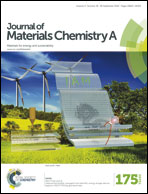Significantly enhanced recoverable energy storage density in potassium–sodium niobate-based lead free ceramics
Abstract
Ceramic-based dielectric materials are regarded as the best candidates for advanced pulsed power capacitors because of their excellent mechanical and thermal properties. Nevertheless, lead-free bulk ceramics show relatively low recoverable energy storage density (Wrec < 2 J cm−3) owing to their low dielectric breakdown strength (DBS < 200 kV cm−1). In order to significantly increase Wrec, we proposed a strategy (compositions drive the grain size to submicrometer) to improve the DBS of lead-free ceramics. In this work, (1 − x)(K0.5Na0.5)NbO3–xSrTiO3 (KNN–ST) ceramics were chosen as a representative to verify the validity of this strategy. The (1 − x)KNN–xST ceramics (x = 0.15 and 0.20) with submicrometer grains (about 0.3 μm) were prepared using pressureless solid state sintering. A large Wrec (4.03 J cm−3) and DBS (400 kV cm−1 with a thickness of 0.2 mm) were achieved for 0.85KNN–0.15ST ceramics. The value of 4.03 J cm−3 is superior to all other Wrec in lead-free bulk ceramics and 2–3 times larger than that of other lead-free bulk ceramics. A large Wrec (3.67 J cm−3) and energy storage efficiency (72.1%) were simultaneously achieved for 0.80KNN–0.20ST ceramics. The results confirm that the (1 − x)KNN–xST ceramics (x = 0.15 and 0.20) are desirable materials for advanced pulsed power capacitors. The findings in this study could push the development of a series of KNN-based ceramics with enhanced DBS and Wrec in the future. On the other hand, this work could broaden the applications of KNN materials in a new field.


 Please wait while we load your content...
Please wait while we load your content...